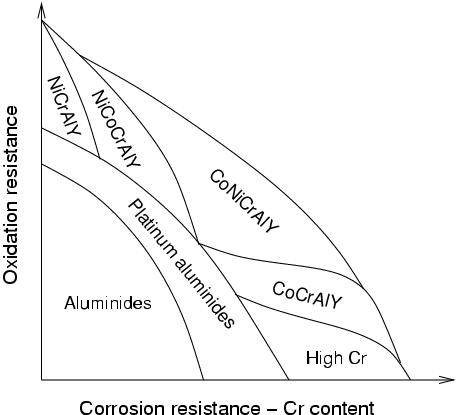
Optimum coating composition in relation to oxidation and hot-corrosion resistance, after M. Schütze, Corrosion and Environmental Degradation Vol. II, Wiley-VCH, 2000.
| Introduction | Bond Coats | TBC | Processes | Resources | |
| [Introduction] [Aluminides] [Pt-Aluminides] [MCrAlY] | Back to phase-transformation home page |
The following table compares the severity of the different surface-related problems for gas turbine applications:
| oxidation | hot corrosion | interdiffusion | thermal fatigue | Aircraft engines | severe | moderate | severe | severe |
| Land-based power generation | moderate | severe | moderate | light |
| Marine engines | moderate | severe | light | moderate |
|
Comparison of problems for gas turbine applications, after F.S. Pettit and G. W. Goward, Coatings for High Temperature Applications, Applied Science Publishers, 1983 | ||||
Recent generations of superalloys for single crystal turbine blades contain relatively high percentages of refractory elements such as Ta, W or Re which enhance the high-temperature mechanical properties (SCT 1997 CHEN).
This, however, is done at the expense of Cr and Al. Given the severe environmental conditions in which the blades operate, the removal of the elements (beneficial for oxidation resistance) implies even greater degradation problems.
To palliate for this lack of appropriate oxidation.corrosion resistance, an
external coating is applied to the blades. Its purpose is to allow for the
growth of a resistant oxide layer.
Of all possible oxides,
 |
Optimum coating composition in relation to oxidation and hot-corrosion resistance, after M. Schütze, Corrosion and Environmental Degradation Vol. II, Wiley-VCH, 2000. |
The two most widely used types of coatings are aluminides (NiAl or Ni2Al3) and MCrAlY (`emcrawlee', where M is Fe and/or Cr) coatings. The formers are obtained by surface enrichment by diffusion, the later by plasma spray or EBPVD. An additional ceramic coating is often applied to high-temperature components (TBC, thermal barrier coating). In this context, the oxidation resistant coatings also provide a `transition' layer on which the TBC adheres better than on the substrate. For this reason, the oxidation resistant layer is also referred to as bond coat.
When the Al content of the coating is too low, other oxides than
Blade integrity is now critically dependent on these coatings and possibly additional ceramic thermal barrier coatings. Unfortunately, `prime-reliability', the concept of a coating whose life does no longer condition that of the blade, has not been achieved yet. With the increasing cost of the blades themselves, the practise of coating renewal has developed. In this operation, a gas turbine is taken apart, each blade is dismantled, its surface cleaned and a new coating applied.
With, on one hand, the prospect of coating failure leading to catastrophic blade loss, and on the other hand an extremely expensive maintenance process, it is no surprise that much research is dedicated to improving the evaluation of remnant life.
| conditions of use | 2004 Thomas Sourmail. | Feedback greatly appreciated |